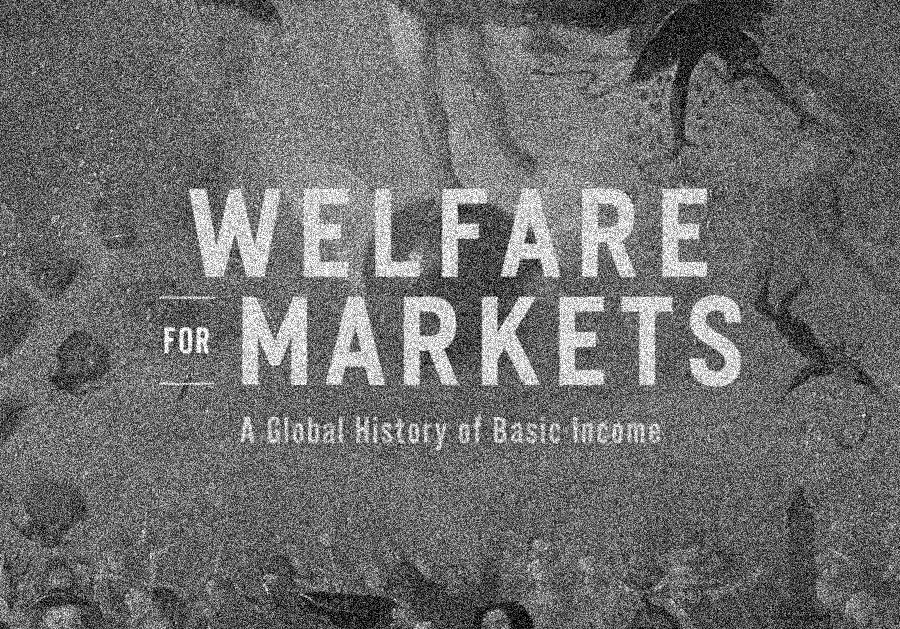Cash Dreaming
Welfare for Markets examines the various political, economic, social, and ideological transformations that allowed basic income to be dressed up as a smart idea. Today, rather than succumb to the dominance of money, we should resume an older conversation about the collective determination of needs.

A Review of Anton Jäger and Daniel Zamora Vargas, Welfare for Markets: A Global History of Basic Income (Chicago: University of Chicago Press, 2023).
Universal basic income is, at root, a silly idea—silly philosophically in reducing human needs in their infinite complexity and historical specificity to questions of market access; silly practically in that affordable basic incomes are inadequate, and adequate basic incomes are unaffordable. Most of all it is silly as an emancipatory proposal, in that UBI can by itself only promise freedom within, rather than from, the market. A better society would undoubtedly involve some direct transfers, but always as supplementary and secondary to robust, public sector programs. The enthusiasm for UBI as a catch-all solution to various social ills is a testament to just how confidently the cart can be put before the horse.
Anton Jäger and Daniel Zamora Vargas’s Welfare for Markets: A Global History of Basic Income is, as the subtitle says, a history of basic income, but it is more fundamentally a history of the various political, economic, social, and ideological transformations that allowed this silly idea to be dressed up as a “smart” one. In their telling, it was only once “the abstract universality of the money form came to triumph over the concrete universality of a decommodified public sector with full employment provisions” that basic income, the “utopia for a world that has lost faith in utopias”, came to be seen on both Left and Right as a viable idea (9). As the historic conditions that gave birth to trade unions and demands for social ownership of things like healthcare and housing began to shift in the latter half of the twentieth century, “cash transfers became an elegant way of conducting social bargaining without passing through corporatist channels” (7).
Today the trends associated with neoliberalism (“increasing abstraction and privatizing of needs, the decentering of labor as a source of social identity, and the disorganizing of civil society into a more atomized landscape”) have wiped away the vestiges of the New Deal order (165). No surprise, then, that a wide variety of disparate figures, from Mark Zuckerberg to David Graeber, Richard Branson to Yanis Varoufakis, have championed UBI: it is the manifest dream-thought to the latent monetization of all life.
The opening chapter, “An Anti-Mythology,” shows how the dominant political “languages” before the 1930s—namely, an “agrarianism” centering on the question of how to distribute land in a stable republican political order and a “producerism” insisting on the centrality of a work ethic to this same order (16)—prevented any serious consideration of cash transfers as a social policy. Milton Friedman’s “negative income tax” (NIT), an idea that could only make sense in the consumer society birthed in the interwar period, features as a conceptual turning point in the second chapter. For the unfamiliar, the NIT is as it sounds: not a positive income tax paid to the government by people with money, but a negative income tax paid by the government to people without it. Chapter 3, “Cash Triumphs,” then traces the strange adoption of Friedman’s idea as an “elegant, practical, and policy-neutral tool, capable of transcending classical oppositions between left and right but also offering an alternative to the patronizing views of classical liberalism and the worker-centered welfare policies of the ‘Old Left’” (90-91). Not just libertarians but even ostensible socialists like Michael Harrington and James Boggs turned against full employment politics, citing the looming automation revolution, the cultural specificity of poverty, and the broad failures of the welfare state. The chapter ends with the birth of Supplemental Security Income (SSI) and the Earned Income Tax Credit (EITC), neither of which were Friedman’s NIT but both of which were patterned after it.
Chapter 4 makes much of the same argument as Chapter 3 but for the European case, where again many leftists concerned with the cybernetic revolution turned against the “unholy ‘statist’ alliance” of “both an ‘Old Left’ and an ‘Old Right’”: “It was this dual revolution, exemplified by thinkers such as Herbert Marcuse, Michel Foucault, Ivan Illich, Bram van Ojik, Roel van Duijn, Félix Guattari, Toni Negri, André Gorz, and Philippe Van Parijs, many of whom ended up as basic income sympathizers and proponents—that laid the groundwork for the European UBI wave” (97). The final chapter, “Rethinking Global Development at the End of History,” examines the shift of postcolonial states away from the goals of industrialization and job creation, and toward the end of giving “people money so they could sustain themselves as they saw fit” (128). More ambitious intentions for development gave way to a narrow focus on poverty alleviation, eventually leading to the “development without development” exemplified in Jeffrey Sachs’ Millenium Villages Project. “With the right investments in human capital, basic needs, and small farmer,” Sachs promised, West Africans in his experimental villages would transform themselves into “effective entrepreneurs able to lift their communities out of poverty” (156). Unsurprisingly, the $120 million project produced “‘no discernible impact’ on consumption-based poverty” (157).
The epilogue, “Basic Income in the Technopopulist Age,” brings us up to date with contemporary developments in the UBI world, all pale reflections of the dream established by Friedman’s NIT. Perhaps what the authors see as the most damaging ideological effect of the cashification of welfare is a widespread inability today to understand and articulate human needs as collectively defined: “Rather than being seen as constituted through a democratic process and transactional politics, needs [are] simply be revealed as consumer choices or in our new virtual ecosystems” (172). The great range of national stories that Jäger and Zamora Vargas tell all undergird their thesis that cash transfers become an attractive option when we give up on the collective definition and fulfillment of human needs, a project imperfectly manifested in the post-war welfare state, and leave everything to the “efficiency” of the markets.
My only criticisms of the book are really just invitations to extend the argument. First, for all of the references to “the minimum” and a “floor without a ceiling” (125), there is no direct discussion of the minimum wage, which could be a unique point of reference in their story. The minimum wage is neither a central concern for full employment politics nor is it for those who wish to sever the link between jobs and income—the ultimate goal of UBI advocates. The minimum wage was established in the United States by the Fair Labor Standards Act, one of the key bills that Frances Perkins pushed in the wake of the demise of the National Industrial Relations Act. Though it was never their leading concern, “raising the floor” was certainly a goal of the New Deal planners. And even amidst an efflorescence of interest in UBI, the minimum wage continues to be a battleground issue today for the Left: some of the most successful grassroots electoral efforts in the United States have been around minimum wage ballot initiatives. Weaving the history of the minimum wage into that of basic income could have further demonstrated the abstract nature of thinking about the latter.
The second criticism is more substantive and complicates the basic thesis of Welfare for Markets. Throughout, Jäger and Zamora Vargas counterpose the “New Deal’s service-based programs” (43) to the cashification of welfare, but this “services to cash” story omits important changes in the “services” model of the New Deal order, as well as the persistence, and indeed growth, of those services in the neoliberal period. First, the stark differences between the alphabet programs of Roosevelt’s New Deal and Johnson’s War on Poverty are generally minimized in the book, and, without clearly differentiating the two, the turn to cash transfers can appear undermotivated. According to Adam Yarmolinsky, the War on Poverty planners debated early on “whether to concentrate on creating jobs for people, preparing jobs for people, or preparing people for jobs”, and they “decided for the latter”. The “services strategy” that Nixon turned against was thus a failing patchwork of educational and job training programs, which were criticized not only by people like Harrington and Boggs but also by A. Philip Randolph and Bayard Rustin. Here’s Rustin on Johnson’s War on Poverty:
The approach is basically wrong! We do not need paper wrappings, we need a new package. If a little Negro child benefits from Head Start, fine, but this is not the answer. We take some boys from street corners and send them to the Job Corps, at the same time that the Job Corps states that 50 percent of the boys they train cannot find work. I could have told them that the very day it started. Or we can create bands for the children to play music, or, as Mayor Lindsay is planning in New York City, we can send Shakespeare to the ghetto. I oppose none of these programs as such, but note this. In 1910 a Moynihan Report could have been written about the Italians: they were all criminal, all carried stilettos, all were involved in crime and broken families. In 1900, an even more vicious study could have been written about the Irish: they were called “Shanty,” which meant “white nigger,” and characterized as filthy, dirty, and unintelligent. Their families were also said to be disorganized. But, as the family heads of both these groups were permitted to gain economic independence, the problems in their communities and family life gradually disappeared. The same thing will happen when we give economic security to the heads of Negro families, and not before.
Jäger and Zamora Vargas are no doubt keenly aware of the myriad failures of the War on Poverty, but the implications of the fact that the criticism “that government administration did not work” was coming from both the New Leftists and the full employment advocates are not explored (86). In addition, despite its manifest inadequacies, the services approach did not wither under the heat: indeed, Johnson’s Economic Opportunity Act set the stage for the rapid growth of nonprofit service providers that has continued into the present. “Service provision” thus never disappeared, though it has been increasingly devolved to the third sector. Nonprofits have been the beneficiaries of welfare reforms like the Bill Clinton’s Personal Responsibility and Work Opportunity Reconciliation Act, which actually curtailed cash assistance but offered a “windfall of resources in program areas of interest to nonprofits.”
Of the triumph of market-friendly welfare reforms in the neoliberal era, there can be no doubt, but the result was not just “smart” proposals to drop coins from the sky: it has also involved the ballooning of the nonprofit sector and the corresponding devolution of state functions to private entities. My hunch is that there’s an interesting dialectic of failure involved in the interplay between nonprofit service expansion and the increasing appeal of cash transfers. When Facebook co-founder Chris Hughes touted the brilliant simplicity of cash transfers, he opposed the approach to that not of the post-war welfare state but of nonprofit executives (161).
But these are merely different directions to extend the story. The basic thesis of Welfare for Markets, that the very appeal of cash transfers is predicated on succumbing to the dominance of markets over our lives, is an urgent one. We need today to resume an older conversation in which the realities of social life and the possibilities for human flourishing, rather than merely what’s on the market and who’s got access to it, are front and center. In On Human Needs, a touchstone for Jäger and Zamora Vargas, Kate Soper wrote of the need for “a continual evaluation of [society’s] needs and a continual determination of the ends towards which it shall be a means” that does not evade “the question of needs by reading its needs in what it in fact consumes”. In looking beyond basic income to the market society that makes it appear to be a serious idea, Welfare for Markets shows clearly how this “collective determination of needs” (10) is foreclosed when cash rules our dreams.
Benjamin Y. Fong is the author of Quick Fixes: Drugs in America from Prohibition to the 21st Century Binge (Verso, 2023).


